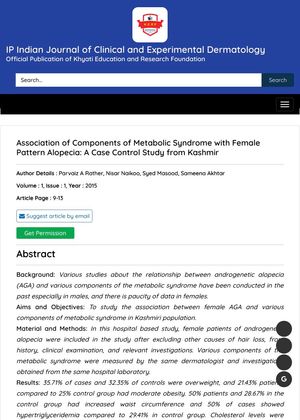Association of Components of Metabolic Syndrome with Female Pattern Alopecia: A Case Control Study from Kashmir
January 2015
in “
IP Indian journal of clinical and experimental dermatology
”
female androgenetic alopecia metabolic syndrome hypertriglyceridemia elevated cholesterol raised LDL levels lower HDL levels raised blood pressure elevated glucose levels polycystic ovarian pathology female pattern hair loss high triglycerides high cholesterol high LDL low HDL high blood pressure high blood sugar PCOS

TLDR The study concluded that women with female pattern hair loss had higher waist circumference, triglyceride levels, lower HDL, and blood glucose levels compared to those without hair loss.
The 2015 study "Association of Components of Metabolic Syndrome with Female Pattern Alopecia: A Case Control Study from Kashmir" investigated the relationship between female androgenetic alopecia (AGA) and various components of metabolic syndrome in the Kashmiri population. The study found that 35.71% of cases and 32.35% of controls were overweight, 21.43% of patients and 25% of controls had moderate obesity, and 50% of patients and 28.67% of controls had increased waist circumference. Additionally, 50% of cases showed hypertriglyceridemia compared to 29.41% in the control group, and 14.28% of cases had elevated cholesterol levels compared to 18.38% in the control group. The study also found that 28.57% of cases had raised LDL levels compared to 15.44% in the control group, and 7.14% of cases had lower HDL levels compared to 22.79% in the control group. Furthermore, 14.28% of cases had raised blood pressure compared to 18.38% of controls, and 14.28% of patients had elevated glucose levels compared to 34.59% in the control group. Lastly, polycystic ovarian pathology was detected in 21.43% of cases compared to 10.29% in the control group. The study concluded that there were statistically significant differences between cases and controls regarding raised waist circumference, hypertriglyceridemia, low HDL, and raised blood glucose levels. However, the diagnostic criteria of metabolic syndrome were not applicable to any of the cases in the study or control group.





